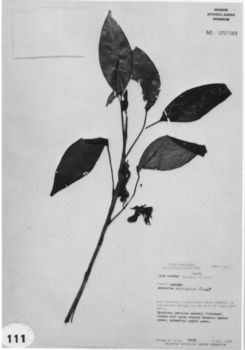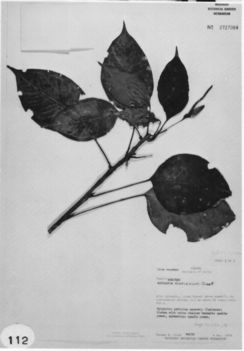


Anthurium pittieri var. morii Croat, var. nov.
TYPE: Panama. Code: Alto Calvario cloud forest along Continental Divide above sawmill, 5.2 mi. N of El Copé, 930 m, Croat 49180 (MO 2727064, holotype; K, PMA, SEL, isotypes).
Planta scandens, epiphytica aut terrestris; internodis 1-8.5 cm longis; cataphyllum membranaceum findens in fibris tenuibus, pallidibus; petiolus subteres. (0.5-)1-7(-11) cm longus; lamina siccitate modice membranacea et denigrata, ovata, interdum elliptica aut oblongo-elliptica, basi acuta ad raro obtusa; inflorescentia foliis breviora; pedunculus teres, 2-9 cm longus; spatha viridis, membranacea, oblongo-lanceolata, 2.2-4 cm longa, 6-10 mm lata, decurrens 1-1.5 cm; stipite 2-17 mm longo; spadix viridis, 1-4 cm longus; baccae luteae ad pallide aurantiacae, obovoideae, 10-11 mm longae, 6-7 mm diam.
Scandent, epiphytic or terrestrial; internodes 1-8.5 cm long (mostly 1.5-2); leaf scars inconspicuous; roots slender, relatively numerous at the lower nodes, few or none from the upper nodes: cataphylls thin, ensheathing stem, narrowly rounded and subapically apiculate at apex ("the apiculum 1-5 mm long), promptly weathering to pale thread-like fibers or deciduous, sometimes with the thickened basal portions persisting at the upper nodes.
LEAVES scattered along the upper part of the stem; petioles (0.5-)1-7(-11) cm long, subterete, narrowly flattened adaxially. sometimes the margins weakly raised; blades usually ovate, sometimes elliptic or oblong-elliptic, drying moderately thin, gradually acimunate at apex (the acumen flat, inrolled minutely) acute to rarely obtuse to attenuate at the base, 7-14 cm long, 2-7.3 cm wide, broadest usually at the middle or in the lower third; drying dark brown to blackened; both surfaces semiglosssy. the lower surface often much paler; midrib weakly raised above, almost flat below, darker than the surface, drying raised; primary lateral veins 7-11 per side, departing midrib at 35-55ˇ angle, moderately straight to the collective vein, moderately obscure on fresh blades, drying prominulous at least on lower surface, sometimes paler than the surface above on dried leaves; scarcely more prominent than the interprimary veins: lesser veins not visible; collective vein arising from the base, 2-6 mm from the margin, drying prominulous on lower surface.
INFLORESCENCE mostly from the uppermost leaf axils, usually shorter than leaves; peduncle terete, 2-9 cm long, 1-2 mm diam., usually to 2 times longer than the subtending petiole; spathe green, moderately thin, oblong-lanceolate, 2.2-4 cm long, 6-10 mm wide, broadest just above the base, narrowly acuminate to narrowly rounded and cuspidate at apex, acute at base and decur-rent 1-1.5 cm, inserted at 20-30ˇ angle to the peduncle; stipe 2-17 mm long; spadix slender, gradually tapered toward apex, green, 1-4 cm long, 2-3 mm diam. near the base, 1-2 mm diam. near apex; flowers square, 3.1-3.3 mm wide in both directions, 2-3 flowers visible in the principal spiral, 3÷4 flowers visible in the alternate spiral; tepals semiglossy, the lateral tepals 2-2.3 mm wide, the inner margin broadly rounded, the alternate pair with the inner margin concave; pistil usually weakly raised; stamens held at the level of the tepals in a relatively close circle around the pistils (the intervening space narrower than the anthers); anthers 0.4 mm long, 0.8 mm wide (dried); the thecae subrounded.
INFRUCTESCENCE with berries yellow to pale orange, obovoid, 10-11 mm long, 6÷7 mm diam., rounded at apex; seeds broadly ovoid, flattened, truncate to broadly sunken at apex, rounded at the base, surrounded on 3 sides by a gelatinous, sticky substance. Figs. 111 and 112.
Anthurium pittieri var. morii is endemic to western Panama from Chiriquí and Bocas del Toro Provinces to Code at mostly 900 to 2,066 m in premontane and lower montane rain forest life zones.
It is distinguished by its scandent habit with slender stems, its elongate internodes, its leaves that dry somewhat blackened, and by its prominently decurrent spathe, prominently stipitate, green spadix, and obovoid yellow to pale orange berries. Variety morii is similar to A. carnosum, which has similar leaves and long internodes, but that species diners in having a spathe that is not at all decurrent. The variety can also be confused with A. interruptum, another scandent species with elongate internodes and leaves that also dry blackened, but the latter species lacks the decurrent spathe, has reddish berries, and its stems have an elongate internode alternating with two or more short internodes.
This variety is named in honor of Dr. Scott Mori who made the first collection.
 |
 |
Map of Mesoamerican specimens with coordinates
Panama Bocas del Toro: Cerro Colorado, 1400-1700 m,, 24 Oct 1977, Folsom 6130
(MO).
Panama Chiriquí: Cerro Pate Macho, 1700-2100 m,, 26 May 1981, Sytsma et
al 4898 (MO).
Panama Chiriquí: Cerro Colorado, 1390 m,, 15 July 1976, Sullivan
394 (MO).
Panama Chiriquí: Cerro Colorado, 1400 m,, 25 July 1979, António 1435
(MO).
Panama Chiriquí: 1200-1500 m,, 12 Mar 1976, Thomas B. Croat 33130 (MO).
Panama Chiriquí: Cerro Colorado, 1290-1410 m,, 15 July 1976, Thomas B. Croat 37249 (MO).
Panama Chiriquí: 6200 ft,, 18 Nov 1978, Hammel 5712 (MO).
Panama Chiriquí:
1200-1500 m, 8.47N 82.13W, 25 May 1984, H.W. Churchill 5301 (MO).
Panama Chiriquí:
1200 m, 8.41N 82.14W, 25 May 1984, H.W. Churchill 5330 (MO).
Panama Chiriquí:,
7 Dic 1996, E. Montenegro 1596 .
Panama CoclŽ: Continental Divide, 930 m,, 06
Dec 1979, Thomas B. Croat 49180 (MO).
Panama CoclŽ: Continental Divide, 900 m,,
19 Jan 1987, Thomas B. Croat 44552 (MO).
Panama CoclŽ:, 01 Feb 1977, Folsom &
Collins 1545 (MO, SEL).
Panama CoclŽ: El CopŽ Region, 900 m,, 04 Apr 1977, Folsom
& Robinson 2410 (MO).
Panama CoclŽ: El CopŽ Region, 800-900 m,, 20 APr 1977,
Folsom & Jaslon 2682 (MO).